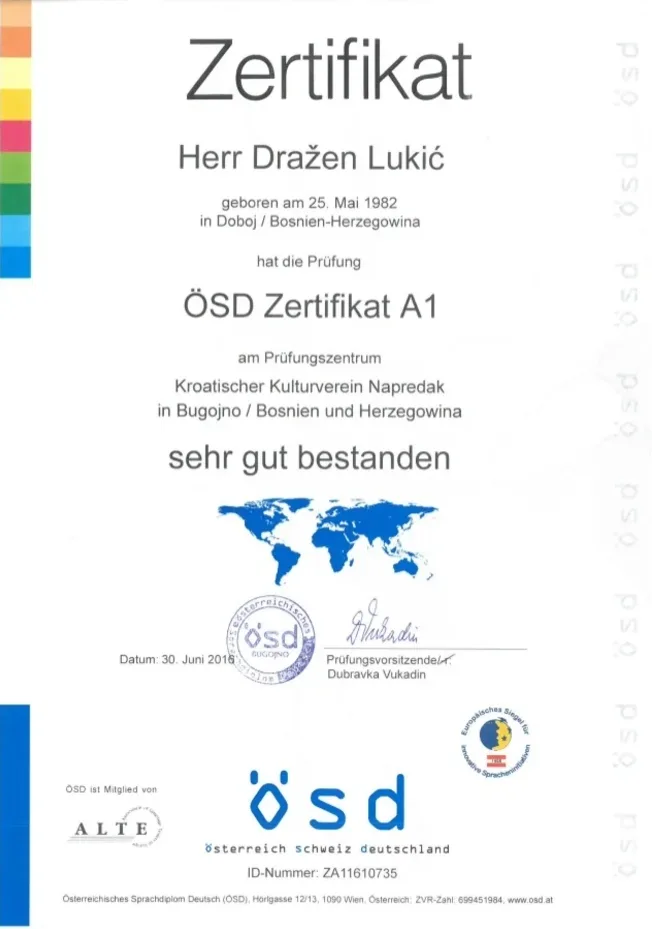Comprehending the ÖSD Exam: A Gateway to Proficiency in German
The ÖSD (Österreichisches Sprachdiplom Deutsch) exam is a standardized language efficiency test developed to evaluate and license German language abilities. Acknowledged globally, the ÖSD exam accommodates numerous learners, varying from novices to advanced speakers. This post intends to supply a useful summary of the ÖSD exam, detailing its structure, levels, preparation methods, and regularly asked concerns.
sprachzertifikat a1 of the ÖSD Exam
In a globalized world where efficiency in numerous languages is extremely valued, the ÖSD exam serves numerous vital purposes:
Accreditation of Language Proficiency: The ÖSD exam provides certificates that are acknowledged in Austria and other German-speaking countries, facilitating job opportunity and university admissions.
Standardized Assessment: The exam provides a standardized evaluation of language skills, which can be helpful for scholastic and expert functions.
Structured Learning Path: The ÖSD offers a clear framework for language students, guiding them toward accomplishing specific language objectives through a structured curriculum.
Structure of the ÖSD Exam
The ÖSD exam is divided into different levels lined up with the Common European Framework of Reference for Languages (CEFR). Each level tests four key language skills: listening, reading, composing, and speaking.
Levels of the ÖSD Exam
The ÖSD provides evaluations at 6 levels, representing the CEFR framework:
A1: Beginner
A2: Elementary
B1: Intermediate
B2: Upper Intermediate
C1: Advanced
C2: Proficiency
Each level has specific requirements and expectations, enabling prospects to focus on ideal materials and practices based on their proficiency.
Exam Components
The ÖSD exam is divided into 4 unique parts:
Listening Comprehension: Candidates listen to different audio materials (conversations, interviews, and presentations) and address comprehension questions.
Checking out Comprehension: This section includes texts of varying lengths and complexities, accompanied by questions that assess understanding and interpretation.
Composing: Candidates are needed to produce written texts (letters, essays, or reports) depending on the level, demonstrating their ability to communicate info and arguments successfully.
Speaking: The speaking element normally includes a conversation with an inspector, needing candidates to demonstrate fluency, pronunciation, and grammatical accuracy.
Preparation for the ÖSD Exam
Getting ready for the ÖSD exam needs a strategic technique, integrating various study techniques and resources. Here are some effective methods:
Research study Methods
Enlist in a Language Course: Structured courses can provide assistance and a methodical method to language knowing.
Experiment Sample Tests: Using official ÖSD sample products can familiarize prospects with the exam format and concern types.
Sign Up With a Study Group: Collaborating with peers can enhance finding out through shared understanding and responsibility.

Usage Language Learning Apps: Mobile applications can support language acquisition, providing vocabulary practice and interactive exercises.
Resources
Textbooks and Workbooks: Choose materials that align with the target level of the ÖSD exam.
Online Platforms: Websites committed to language learning typically provide totally free resources, including grammar exercises and vocabulary lists.
Tutoring: Personal direction from knowledgeable instructors can use tailored feedback and targeted practice.
Tips for Success
Set Realistic Goals: Break down the preparation procedure into workable milestones.
Engage with Native Speakers: Regular interaction with native German speakers can improve conversational skills and cultural understanding.
Immerse Yourself in the Language: Consume German-language media-- such as films, podcasts, and books-- to enhance listening and reading abilities.
Practice Regularly: Consistency is type in language learning; assign time every day for practice throughout all four skills.
Regularly Asked Questions (FAQs).
1. What are the primary differences in between the ÖSD exam and other German language examinations?
The ÖSD exam particularly concentrates on modern German usage and culture, using a distinct point of view compared to other tests, such as the TestDaF or the Goethe-Zertifikat. Each assessment has different structures, levels, and focus on numerous skills, catering to specific requirements and target audiences.
2. For how long does it take to prepare for the ÖSD exam?
Preparation time varies considerably based upon the prospect's existing language abilities. Typically, it can take anywhere from a few months to over a year of devoted research study to get ready for each level.
3. Exists an age limitation to take the ÖSD exam?
No, there is ösd a1 for prospects wanting to take the ÖSD exam. People of any ages, from kids to adults, are encouraged to take part based on their language proficiency and objectives.
4. Where can I take the ÖSD exam?
ÖSD exams are administered at various authorized assessment centers worldwide. Candidates can go to the official ÖSD site to discover a center near them and to check offered dates.
5. How are sprachschule österreich scored?
Prospects get a rating for each component of the exam, which is then combined to provide a general proficiency level. Results are generally available a few weeks post-examination.
Conclusion.
The ÖSD exam is a reputable language proficiency test that functions as an essential tool for people looking for to show and accredit their German language abilities. Through effective preparation, structured learning, and access to the right resources, prospects can accomplish their preferred efficiency level, improving their opportunities in both scholastic and expert domains.
